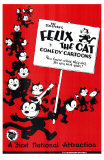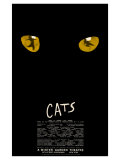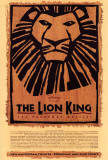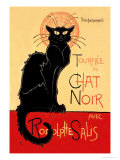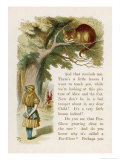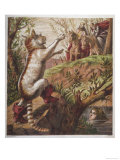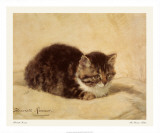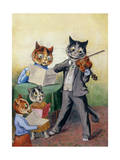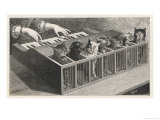|
|
|
“Three Little Kittens
They lost their mittens,
And they began to cry,
Oh, mother dear,
We sadly fear
Our mittens we have lost.
What! Lost your mittens,
You naughty kittens!
Then you shall have no pie.
Mee-ow, mee-ow, mee-ow, mee-ow.” ...
FYI - The nursery rhyme Three Little Kittens, first published in 1853, was described as a traditional folk song. It is attributed to Eliza Lee Cabot Follen, though probably based on a previous, more rustic, version. It may be the source of the idiom “to smell a rat”.
|
|
|
|
Bagheera is the black panther in Rudyard Kipling's Mowgli stories in The Jungle Book.
Kipling describes Bagheera: “Everybody knew Bagheera, and nobody cared to cross his path; for he was as cunning as Tabaqui, as bold as the wild buffalo, and as reckless as the wounded elephant. But he had a voice as soft as wild honey dripping from a tree, and a skin softer than down.”
The word bagh means tiger in Hindi.
|
|
|
|
The Cat in the Hat is a book written and illustrated by Theodore Geisel, using the pen name Dr. Seuss. The Cat in Hat was in response to a challenge by author and critic John Hersey, to provide “brighter, livelier books featuring strange and wonderful animals and children who behave naturally, i.e., sometimes misbehave.” as a means of overcoming the failure of so many elementary students to learn to read.
|
|
|
|
Felix the Cat is a cartoon character from the silent film era. Felix was one of the most recognized cartoon characters, the first to be popular enough to draw a movie audience. His creator Pat Sullivan resisted adding sound to Felix, eventually Felix faded from memory.
|
|
|
|
|
|
|
Cat on a Hot Tin Roof is a play by Tennessee Williams performed on Broadway and made into a 1958 movie.
The “cat” in the play is the beautiful Maggie from a poor background who marries the desolute Brick Politt and into a wealthy family; the “hot tin roof” alludes to the setting of a party where everyone is lying to Big Daddy, a man who doesn't know he is celebrating his last birthday.
|
|
|
|
|
|
|
Maneki Neko, the Beckoning Cat or the Lucky Kitty, has origins in the folklore of Japan.
It is said a cat sitting at a temple entrance raised its paw just as a feudal lord was passing. The man decided to follow the cat into the temple, and just then a lightning bolt struck where he had been standing. Thus his life was saved by the cat.
|
|
|
|
Hello Kitty, a character of a female white cat, with a red bow and no drawn mouth which has been licenced into products with sales of more than $1 billion a year.
|
|
|
|
|
|
|
The Cheshire Cat, a fictional cat from Lewis Carroll's Alice's Adventures in Wonderland, is best remembered as disappearing, his grin the last to fade.
There is no actual breed of cat called Cheshire, but there used to be a brand of cheese from the county of Cheshire that was moulded with a grinning cat face. Since the cheese was always sliced from the tail end, the grin was the last to disappear.
• Brewer's Dictionary of Phrase and Fable, Seventeenth Edition
|
|
|
|
Dick Whittington and His Cat is a folktale about a poor boy whose fortunes are reversed because of his fine cat's ability to catch rats.
There was a real Richard Whittington who was the Lord Mayor of London in the 14th century, but there is no evidence he had a cat or was ever poor.
|
|
|
|
Puss in Boots is the tale of a cat helping an impoverished master, the “Marques de Carabas”, attain wealth through trickery.
French author Charles Perrault included Le Maistre Chat, ou Le Chat Botté (”The Booted Cat”) in his collection of eight fairy tales called Histoiries ou contes temps passé.
|
|
|
|
|
|
|
Are Cats Musical?
Are Cats Musical educational poster teaches the musical language of character and expression in 35 feline illustrations, giving the term and the English translation. Piacevole, maestoso, amabile, grazioso, dolente, con fuoco, serioso, estinguendo, arioso cantabile, agitato, buffo, con brio, con anima, tremolando, capriccioso, sostenuto, con dolore, grave, leggero, affetuoso appassionato, glissando, lamentabile, animato, pomposo, marziale, dolce dolcissimo, giusto, commodo, tempestoso furioso, con espressione espressivo, morendo, scherzando giocoso, brillante, perdendosi...
• music posters
|
|
|
|
Anthropomorphized animals were very popular in Victorian England and artist-illustrator Louis Wain was a master drawing cats and kittens parodying human behavior.
Wain taught the family cat, Peter, to "wear glasses and pretend to read” in order to amuse Emily, his wife who was suffering from cancer.
Author H. G. Wells said of Wain, “He has made the cat his own. He invented a cat style, a cat society, a whole cat world. English cats that do not look and live like Louis Wain cats are ashamed of themselves.”
|
|
|
|
FYI- One of the definitions of Catatonia is excessive motor activity or purposeless agitation; someone was doing a play on words for this vintage illustration.
• more piano posters
|
|
|
| The “Cats” pages are dedicated to Frazier, Blackie, Smokey, Mama Cat, Tabby, Aum, Stormy, Sophia, Leo, Winker, Socks & Spots, Ophelia, and the tiny black kitten rescued from the side of a busy trafficway who is learning to “tywdfe;e” (translation: “type”; see digitgrades), just to name a few, who have graced our life. UPDATE: The tiny kitten is how a two-year old who made peace with the dog, will follow us on walks if given the opportunity, and when he misses the walk, runs to meet us. |
previous page | top | cats | big cats | CATS IN ART
|
|
I have searched the web for visual, text, and manipulative curriculum support materials - teaching posters, art prints, maps, charts, calendars, books and educational toys featuring famous people, places and events - to help teachers optimize their valuable time and budget.
Browsing the subject areas at NetPosterWorks.com is a learning experience where educators can plan context rich environments while comparing prices, special discounts, framing options and shipping from educational resources.
Thank you for starting your search for inspirational, motivational, and educational posters and learning materials at NetPosterWorks.com. If you need help please contact us.
|
|
|


















